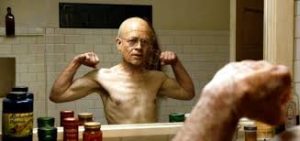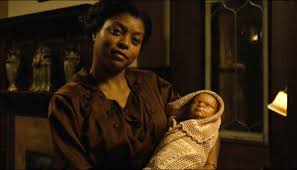32
The Curious Case of Benjamin Button (2008) and the Issue of Ageism
By Evin Holstad
Benjamin Button is a film I have heard of since it first came out and the premise has always perplexed me. One film critic summarizes the plot as such “Where others are born unformed and unwrinkled, Benjamin comes into the world a decrepit old man; where others wither, he dies in a pink and creaseless state of infancy” (Shwarzbaum, 1). This is the story of Benjamin Button played by Brad Pitt who suffers from a fictional disease that affects his development. When first hearing about this film, it assumed it would be an outrageous comedy, something out of an Adam Sandler film or something. However in reality it is a beautiful story that comments on the issue of age and ableism and how we should be accepting of people at any age while incorporating a love story at the same time and was truly one of the most unique films I’ve ever seen.
The film takes place over many different time periods of Benjamin’s life. It begins with his love interest Daisy as an old woman in a hospital bed as Hurricane Katrina is getting ready to fall on New Orleans. She is with her daughter who reads Benjamin’s journal to her mother. As she reads his journal we are taken back in time to when Benjamin was born in 1918 in New Orleans. We are then taken back in time on a journey with him through various times in his life all the way until he is in his 80’s.

Benjamin, with his disorder, has many trials and tribulations as he grows up, maturing as he normally would inwardly, but outwardly appears to be getting younger. Because of the discrepancies between his mental age and his physical age, he is discriminated against at times which is represented in the film through various metaphors, and visual techniques. The main visual techniques used are achieved through CGI that make Brad Pitt appear older, or younger at different stages in his life, and make the people in his life age normally. There is also a metaphor at the beginning of the film where a clockmaker installs a clock in a train station but the clock goes backward, representing Benjamin aging backward.
One of the other main themes in this movie is death. Benjamin, growing up in a nursing home saw countless people come and go in his life. From his many mentors to his adoptive mother, friends, family, most everyone he interacted with in his life, he saw die, however, it never seemed to affect him emotionally. Even at one of the happiest moments of his life, when he finally didn’t need crutches anymore to walk, was immediately met by the death of the preacher helping him. He began to realize that it was easier to live life independently and not to rely on anyone else or have anyone else rely on him.
Most of the characters are representative of the historical period covered by the plot, with many of them being straight white males which was indicative of power at the time. There are some African American characters but for the most part, they are represented as maids or cooks which reinforces the common representative of the time. However, one of the main characters, Queenie, is an African American woman and was Benjamin’s mother figure and she very sympathetic character. She took Benjamin in when he was abandoned by his father, and loved him regardless of his disfigurement. Benjamin was also reliant on a wheelchair and crutches for the first few years of his life.
Benjamin is obviously suffering from some kind of fictional disease that affects his development in some way and because of this, he is often discriminated against. He faces discrimination from the minute he is born when his father first sees him and immediately thinks to drown him in a river. However, he is interrupted and then decides to abandon him at the nursing home. The editing technique of “flashbacks and flashforwards” is the most common one seen in this film as the film is constantly switching between Daisy as an old woman in 2003 and Benjamin in the 1900s. In these flashbacks, there are many scenes where he is discriminated against or treated differently because of his age. “In the Curious Case of Benjamin Button, it is apparent that wellbeing is defined by fitting in: physically, mentally, and socially according to one’s age. I’d say this is a pretty universal in our current society, despite one’s age, sex, or gender. Having a “group” to belong to fulfills our innate need to connect (and be happy) with those around us and I’d say this is a greater challenge in early development years (toddler-childhood) and for the elderly, as they fall into the age outliers of society.” (Unknown, 1). This quote sums up much of the issues that Benjamin has to deal with in his life, regarding not fitting into any group at any stage of his life because he looks different, and facing discrimination because of it. He is often told he can’t do things because of his old withered appearance when in reality he is fully able.
Benjamin spent his years growing up in a nursing home with other old people whose ages match their appearances. However, Benjamin was a 10-year-old boy appearing to be an 80-year-old man. Because of this, he does not fit in with the older people even though he looks like them. He has too much energy and wants to play too much while the older people just want to relax. At the same time, people who are his age also discriminate against him because he looks like an old man. They often call him “boy” in a very negative way which further alienated him from the group. In this way, he never is able to fit into any group at this age and finds companionship in only a few people. One of whom being Daisy. They meet when Benjamin is 12, and Daisy is 6. They begin to become friendly but this is quickly shut down when someone sees them together and tells Benjamin that “he oughta be ashamed of himself” for being an old man playing with a young girl. However, in Benjamin’s mind, he is simply a young kid playing with another young girl. But because of his appearance, this is seen as inappropriate.
One quote from a movie review sums up the issues with Benjamin’s life quite well “Jokes about old people are accepted within our society and older people even laugh at their own deteriorated appearance. There is an ambivalence regarding aging that permeates every level of our society. However, since Benjamin was humbled early by the vicissitudes of aging he did not experience the arrogance that comes with youth.” (Rothaupt, Flom, 1). Benjamin was met with ambivalence from the moment he was born, as his father abandoned him as soon as he saw him. He was treated differently for being old, and never really got to experience the innocence and freedom of being a child.

One element of DPD that was never really discussed in this film is racism. The film was set mainly in the mid-1900’s when racism was rampant and very common in America. Benjamin’s mother figure Queenie is an African American woman however her race, and how that may have impacted Benjamin’s life, are never mentioned. “Missing from the film was the racism present during the time period. Had Ben been a real person, his particularly curious life would have no doubt been further complicated by having an adoptive mother who African American. However, race is never really acknowledged in this film, which instead emphasized the role of a dedicated mother.” (Rothaupt, Flom, 2). While race isn’t the main topic in the film, or even mentioned at all, I think it is somewhat dismissive and privileged of the filmmakers to completely ignore an issue that would have no doubt been relevant at this time and could have made a powerful impact in this film.
When looking for a film to analyze for this piece, I immediately knew I wanted to do Benjamin Button. I had watched it only a few days prior so it was still very fresh in my mind, and the story had stuck with me for days after watching it. Also bear in mind the movie is almost three hours long so I split it up and watched it over a three-day time period. I had heard of this movie for years and it was always intriguing to me and I wondered how they could have made a baby look like an old man, and how they could have made such an outrageous premise into a serious movie. But I believe it was executed very well, and despite what I had heard about the movie prior to watching it, that it was boring or too long, it kept me enthralled the entire time even with breaking it up into three parts. I think it is a great piece that discussed the issue of aging and how it can be viewed negatively when that shouldn’t be the case at all.
Now if the idea of an old-man baby or a baby old-man is intriguing to you at all, then Benjamin Button might be the perfect movie for you. But be prepared to go through a rollercoaster of emotions and come out at the end feeling a little better about aging, and not seeing it as such a negative thing. It happens to all of us and we should rather focus on what we do and achieve during our lives than focus on the things we cannot do during our old age.
References
Jeanne W. Rothaupt & Barbara Flom (2009) The Curious Case of Benjamin Button, Journal of Feminist Family Therapy, 21:4, 287-288, DOI: 10.1080/08952830903347186
Schwarzbaum, Lisa. “The Curious Case of Benjamin Button.” Entertainment Weekly, no. 1029, Jan. 2009, pp. 38–39. EBSCOhost, search.ebscohost.com/login.aspx?direct=true&db=a9h&AN=35943942&site=ehost-live
Uknown User, et al. “OI Engine, an Innovation Management Software Built on Design Thinking.” OpenIDEO, 25 June 2013, challenges.openideo.com/challenge/mayo-clinic/inspiration/the-curious-case-of-benjamin-button.

